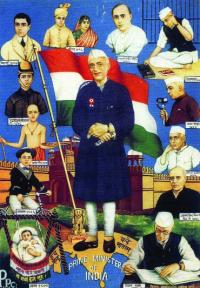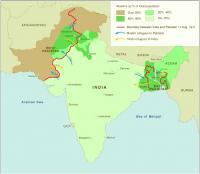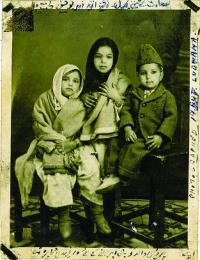Partition: The 1947 partition of India: Irish parallels
Published in
20th-century / Contemporary History,
Devalera & Fianna Fail,
Features,
Issue 4 (July/August 2010),
Volume 18

Train station in Amritsar, Punjab, October 1947. Muslim and Hindu refugees pack trains heading in opposite directions—one to Pakistan, the other to India. (AFP/Getty Images)
The twelve-volume series of official British documents, The transfer of power in India 1942–7, published between 1967 and 1982 is full of references to Ireland, many of them dire warnings about the awful example that Ireland offered to the British government as Indian independence approached. The editor-in-chief, Irishman Nicholas Mansergh, Professor of Commonwealth History at Cambridge, had long been fascinated by the parallels between Ireland and India in their respective struggles for independence. In November 1947, just three months after Indian independence, he told the Royal Institute for International Affairs that the most vital lesson to be learned from the Irish experience was ‘the supreme importance of reconciling constitutional forms with political and pyschological realities’.
Looming cloud
In 1929, eight years after the Anglo-Irish Treaty that made the Irish Free State a self-governing dominion within the British Empire, dominion status became the declared goal of British policy in India. By then the Irish Free State was being hailed as the poster child for the success of dominion status as a way of dealing with troublesome nationalists. That status, however, had been granted very reluctantly to Ireland, and to many British Conservatives in the 1930s the very idea of giving India dominion status was inconceivable. Lord Birkenhead, one of the British signatories of the 1921 Irish treaty and later secretary of state for India, considered it ‘frankly inconceivable that India will ever be fit for self-government’.

The many hats of Pandit Jawaharlal Nehru—from his school days at Harrow, through his long political career, to prime minister of independent India in distinctive Gandhi cap. Churchill’s secretary of state for India, L.S. Amery, perceived disagreeable comparisons with Éamon de Valera.
These apprehensions seemed to be justified when Éamon de Valera and Fianna Fáil, the voices of unappeased nationalism, came to power in 1932, just nine years after the end of the Irish civil war. Prominent members of the Indian National Congress, notably Subhas Chandra Bose and V.J. Patel, visited Dublin and were received as welcome guests by de Valera and his ministers. In 1937 de Valera’s new constitution, which was republican in all but name, was adopted. After consultation with the other dominions, the British government declared that the new constitution would not affect Irish membership of the Commonwealth. This helped to paper over the immediate cracks in the Commonwealth fabric but only postponed the day of reckoning as Indian independence drew nearer in the 1940s. Would Congress demand an independent republic? And what about the threat of partition as tensions between Hindus and Muslims escalated?
Hindus, Muslims and World War II
The 1935 Government of India Act increased the powers of the provincial governments, widened the franchise in preparation for elections in 1937, and provided for a federation between the states of British India and the nominally independent ‘princely states’. Despite its reservations, Congress contested the provincial elections in 1937 and triumphed, winning a majority in nine of the eleven provinces of British India. The act appeared to be working well until the outbreak of World War II, when the viceroy, Lord Linlithgow, declared war on behalf of India without consulting any Indian political leaders. Congress resigned from its provincial ministries.
In March 1940 a Congress party meeting at Ramagarh declared that ‘nothing short of complete independence can be accepted by the people of India’. Congress’s right to speak for India was challenged two days later, however, when the Muslim League passed the ‘Lahore Resolution’, which called for a separate Muslim state of Pakistan. With partition now a real possibility, parallels with Ireland were reinforced and it was no coincidence that in the speech that preceded the resolution the Muslim League leader, Mohammed Ali Jinnah, made a pointed reference to Ireland:
‘To yoke together two such nations under a single state, one as a numerical minority and the other as a majority, must lead to growing discontent and the final destruction of any fabric that may be built up for the government of such a state. History has presented to us many examples, such as the Union of Great Britain and Ireland, of Czechoslovakia and Poland.’
It is interesting that Jinnah chose this parallel and not the more obvious one of Northern and Southern Ireland. He was later to state that he did not regard Muslims as a minority: they were ‘as much a “nation” as the Czecho-Slavs [sic] or the Irish were a nation and as much entitled to a separate homeland’. Jinnah, unlike the Ulster unionists, was careful not to define what he meant by Pakistan. His opponents in Congress, like Sinn Féin on Ulster in 1921–2, believed that Pakistan, a motley collection of Muslim states on both sides of the subcontinent, would never survive.
Churchill becomes prime minister

The partition of India, August 1947, showing the major movements of refugees in either direction. (Sarah Gearty)
When Winston Churchill became British prime minister in May 1940 he appointed a new secretary of state for India, L.S. Amery, who had served as colonial secretary and Dominions secretary in the 1920s. It was an odd appointment, as they had strongly disagreed over India in the 1930s. Amery did not believe that responsible government for India could stop short of dominion status and argued that it was wiser to concede the demand for self-government than to keep the safety valve screwed down. But Amery loathed the Congress leaders, especially Nehru, in whom he perceived disagreeable comparisons with de Valera. Nehru, he wrote in 1942, was ‘a man who has spun himself into a cocoon of his own perversion of history and diatribes against the British which blind him to all real facts. The type is not unfamiliar among nationalist intellectuals in other countries—de Valera for instance’, though Amery conceded that the latter ‘evidently has some executive ability’.
A new statement was drafted in reply to the Congress demands: dominion status was again declared to be the goal of British policy in India but there was no mention of the date or method of introduction. The most controversial aspect of the statement was that Muslims were guaranteed that there would be no transfer of power if the authority of any system of government was denied ‘by large and powerful elements in India’s national life’. This statement gave the Muslim League a virtual veto over any constitutional advance and reinforced the parallels with Ireland, as Amery recognised. The breakup of India ‘on Ulster and Éire lines’, he wrote, would be ‘a most disastrous solution’. He later came to believe, however, that partition might not be such a catastrophe and calculated that Indian divisions could allow British influence to remain predominant. Not surprisingly, Congress rejected the British offer.
The entry of the United States into the war in December 1941 put considerable pressure on Churchill about India. The lord privy seal, Labour MP Sir Stafford Cripps, was sent to India in spring 1942 to try and reach a settlement with Congress. It was proposed that at the end of the war, following new provincial elections, a constituent assembly would be elected in which the Indian states would take part. But the crucial proviso was that any province of British India had the right to opt out if it was not prepared to accept the new constitution. The British government would then be prepared to draft new constitutions with any of the opting-out provinces, which would give them the same status as the new Indian union.
Other Commonwealth leaders objected that the British proposals actively encouraged partition. The South African prime minister, J.C. Smuts, warned Churchill in March 1942 against using ‘Irish tactics of partition’. In a letter to the Canadian prime minister, Mackenzie King, Churchill argued that the question to be solved was not between the British government and India but ‘between different sects or nations in India itself . . . Moslems declare they will insist upon Pakistan, i.e. a sort of Ulster in the North’. Amery also used Ireland as a justification:
‘Nobody is going to work a constitution which has been imposed upon them against their will . . . The British constitution was pretty nearly wrecked by the Irish. If we had to force a majority constitution upon India I have no doubt the Moslems would probably wreck it in the parliamentary sense, if they did not wreck it in the military sense long before.’
The Cripps mission
![Christian and Hindu iconography are blended in this ten-stage representation of the life of Gandhi by the artist Dinanath. ‘If he insists on committing suicide [by going on hunger strike]’, wrote Amery in August 1942, ‘. . . I would certainly not tolerate the kind of day-to-day bulletins which were issued about the wretched Lord Mayor of Cork [Terence MacSwiney] years ago.’](https://www.historyireland.com/wp-content/uploads/2013/03/79_small_1279711733.jpg)
Christian and Hindu iconography are blended in this ten-stage representation of the life of Gandhi by the artist Dinanath. ‘If he insists on committing suicide [by going on hunger strike]’, wrote Amery in August 1942, ‘. . . I would certainly not tolerate the kind of day-to-day bulletins which were issued about the wretched Lord Mayor of Cork [Terence MacSwiney] years ago.’
The Cripps mission to secure Indian cooperation in the war effort had a more obvious Irish parallel since this had been the very purpose of Malcolm MacDonald’s secret missions to de Valera on behalf of the British government in the early summer of 1940, when he offered Irish unity in exchange for immediate entry into the war on the Allies’ side. One of de Valera’s reasons for refusing this offer was his belief that, once the wartime emergency was over, the offer of unity would be reneged upon. It was a view shared by Gandhi, who famously called the Cripps offer a post-dated cheque on a failing bank. Their scepticism about Churchill’s sincerity was borne out by his later contemptuous comment on the Cripps offer that ‘we made [it] when in a hole and can disavow it because it was not accepted at the time’.
Within months of the Cripps mission, Congress embarked on the ‘Quit India’ movement, which culminated in the arrest of the party’s leaders in August 1942. The British authorities were anxious to arrest Gandhi and even deport him, undeterred by the likelihood that he would go on hunger strike. ‘If he insists on committing suicide’, Amery wrote in exasperation, ‘surely he might as well do it in seclusion and India be informed of the fact afterwards? I would certainly not tolerate the kind of day-to-day bulletins which were issued about the wretched Lord Mayor of Cork [Terence MacSwiney] years ago.’ The government’s initial confidence that it had spiked Congress and the Quit India movement quickly faded. Frantic attempts to find links between Congress and the Nazis, a ‘German Plot’, were unsuccessful (and must have amused de Valera, who was jailed after similar efforts with Sinn Féin in 1918).
Independence and partition
In July 1945 Churchill and the Conservatives were swept from power by a landslide Labour victory. Time was now running out in India. The machinery of the Raj was grinding to a halt and Hindu–Muslim tensions were causing serious disturbances. In January 1947 Lord Louis Mountbatten became the last viceroy of India, with instructions to transfer power by June 1948. In March 1947 Congress decided to accept partition and two months later agreed to accept dominion status while a new Indian constitution was being drafted. These decisions drastically accelerated the date for the transfer of power, which was now set for 15 August 1947, ten months earlier than planned.
Two boundary commissions were set up for Bengal and the Punjab, led by a British judge, Sir Cyril Radcliffe, who was given the task of dividing 88 million people and 175,000 square miles of territory in just five weeks in July and August 1947. When the boundary decisions were announced, millions of Hindus, Muslims and Sikhs struggled to get on the ‘right’ side of the new borders. Many were massacred. The exact figures have never been ascertained but recent estimates put the figures at approximately one million.
Partition in Ireland and India

In response to a Channel 4 documentary to mark the 60th anniversary of the partition of India in March 2007, this photo of three Muslim children, taken in Ludhiana, Punjab, in January 1947, was posted by ‘Shakila’ on the About Film website. It shows her mother (centre), Aunt Anwer (left) and Uncle Bali (right). All three survived a c. 100-mile trek to Lahore on the Pakistani side of the border, but in the confusion Anwer was separated from the others and wasn’t reunited with her family until 1975.
In Ireland power was transferred in a political triangle consisting of a nationalist majority at its base with a discontented minority—the Ulster unionists—and the departing imperial power, Britain, on either side. In Ireland it was divide and depart; the British settled with the unionist minority before they settled with the nationalist majority. Partition was seen by both the British government and the new Irish Free State as a temporary measure, but as it became more deep-rooted it was a cause of persistent instability for every Irish government after 1922 and laid them open to the charge that they had sold out the nationalist minority in Ulster. The border decreed by the 1920 Government of Ireland Act was left unchanged after the 1925 Boundary Commission, preserving in stone the political, religious, social and economic conseqences of a flawed partition.
In India there was the same triangle (though the Sikhs were yet another powerful minority) but partition and withdrawal happened simultaneously. In India partition was the price of independence and there were few Indian illusions that it was temporary. But that did nothing to diminish the belief held by many in both Ireland and India that British policies had encouraged unionist and Muslim resistance to the creation of the new states. In both countries boundary commissions determined disputed frontiers. In India and Pakistan this led to bloody massacres and huge movements of population from each side of the new borders. The legacy was even more unstable. Two wars with Pakistan in 1965 and 1971 were followed by the eventual disintegration of Pakistan itself and the creation of Bangladesh. There is still the long-running dispute over Kashmir.
In 1978, 30 years after Indian independence, Nicholas Mansergh published The prelude to partition, in which he compared and contrasted the aims of British policy-makers in Ireland and India. Regarding the question of whether partition could have been avoided, Mansergh observed that ‘it seems the time of choice comes early, while two communities stand side by side and, despite illusions that continue to be entertained, is likely to be past, short of the use of force, once they stand to face’. HI
Deirdre McMahon is Lecturer in History at Mary Immaculate College, Limerick.
Further reading:
T.G. Fraser, Partition in Ireland, India and Palestine: Theory and Practice (London, 1984).
N. Mansergh, Nationalism and Independence (Cork, 1997).
N. Mansergh & E.W.R. Lumby (eds), India: The Transfer of Power (HMSO, London, 12 vols. 1970-83).
P. Moon, Divide and Quit (New Delhi, 1998).



![Christian and Hindu iconography are blended in this ten-stage representation of the life of Gandhi by the artist Dinanath. ‘If he insists on committing suicide [by going on hunger strike]’, wrote Amery in August 1942, ‘. . . I would certainly not tolerate the kind of day-to-day bulletins which were issued about the wretched Lord Mayor of Cork [Terence MacSwiney] years ago.’](https://www.historyireland.com/wp-content/uploads/2013/03/79_small_1279711733.jpg)

















